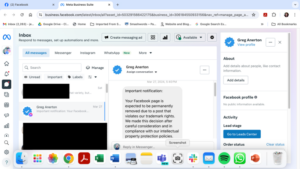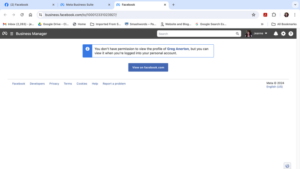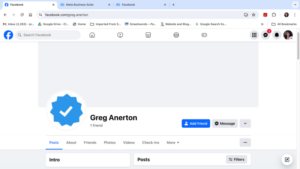How to Spot a Facebook Phishing Scam
Have you ever seen a Facebook phishing scam on your business pages?
If you've received an "urgent message" from "Facebook support" about supposed "copyright infringement"...you've received a scammy message. Here's how to spot them and what to do about them.
What Does a Facebook Phishing Scam Message Look Like?
This is an actual message I received today. I own a gardening blog which I write for fun called Home Garden Joy. Every day there are at least one, if not more, messages like this in my inbox. (I put black boxes over actual messages from readers.)

A few thing that immediately tip you off that this is a scam:
"Greg Anerton" doesn't have a profile picture. Instead, it uses the blue checkmark. Facebook introduced the blue checkmark a few months ago to indicate that a profile is verified. The scammer is using the blue checkmark to make you think this is a Facebook-approved account.
The message says nothing. It means nothing. "Copyright infringement" of a Meta property? What does that even mean?
There's a link to click to reply. I didn't click the link (thank you, but no). But the link itself isn't a Facebook or Meta owned property.
It's Not a Real Person Messaging You
Trying to click on the profile of "Greg Anerton" and I got this message:

Again, what does this even mean?
Typical of a Facebook phishing scam is that if you click on the profile to learn more about the person behind the message, you find out it's nothing. Vapor. A phantom. A bot.
From my personal account, I found "Greg Anerton's" profile:

Well, would you look at that!
Greg has...
- No profile picture
- No information about him
- No banner picture
- One friend
- Only three photos uploaded: the verified checkmark, a fake call center graphic (which I've seen on other spam emails), and an ad in Chinese.
Hmmm....Greg, are you out there? Greg?
Nope, because Greg isn't a person. Greg is a bot. Greg is a scam profile set up to trick business owners into panicking, clicking the link in the message, and then divulging their user name, password, and personal information
Facebook Phishing Scams: How They Work
According to Cybernews, the Facebook phishing scam plays on a business owner's sense of urgency to trick them into clicking the link in the email. Facebook is notorious for randomly taking down posts and images; it suspends accounts without warning and leaves users wondering what they did to deserve being blacklisted. The site relies heavily on automated bots to scan for content that goes against "community standards" which is a euphemism for Facebooks' arbitrary rules.
Business owners who rely on Facebook see these messages and feel a sense of outrage. The messages are cleverly worded to make them seem urgent and reasonable - just click this link and you can tell us your side of the story. Unsuspecting business owners click links from these messages and end up on credential harvesting sites.
A follow up article indicates that the Facebook phishing scams have intensified. I know that my gardening blog receives at least one of these per day with different wording and increasingly frantic wording. One message, which disappeared before I had a chance to screen capture it, threatened to make my entire account disappear within 24 hours if I refused to click the link.
What Happens If You Fall Victim to the Scam
Cybernews states that victims of the scam find themselves locked out of their business accounts. Their accounts now change to "Meta Copyright Infringement Accounts". Like a parasite the scammers lock into the business account and transform it into their own! They then use the business' platform to scam others.
If business owners have a credit card on file with Facebook (to pay for their advertising, for example), many find fraudulent charges on their cards. They have to shut down their credit cards to prevent the scammers from stealing even more from them.
The hardest part? Facebook is truly awful at customer service. Users who have had their accounts frozen by the crooks find they can't get a human being at Meta to help them. They lose years of photos and memories.
Prevent Scammers from Getting Your Info!
- Never click on random links that appear in your inbox.
- Check the profile of the person sending you the message. Zero friends, weird pictures, no posts, name not matching photo or ethnicity, probably scammer.
- Make a download of all your photos from Facebook! I learned this trick from Robyn at Dashboard Interactive Marketing. You can download all your photos. I had some photos on FB that I lost from my personal PC when it suddenly crashed, taking a lot of pictures with it. The only copies were on FB and now I have downloaded my photos and saved them to a cloud host so I won't lose them again. Here are the instructions to download your FB. photos.
Remember that Facebook isn't your friend. It's a platform intent on monetizing your data. Use it for your business to be sure....use it to keep in touch with friends...but use it knowing that if anything happens to your account you are on your own. Take steps to protect yourself and your personal data by being smart and careful and avoid those phishing scams!
Content Advocacy: Encouraging Employees to Brand Cheerleaders
What is content advocacy?
Content advocacy means encouraging employees to share and promote your company's content. It is taking steps to make it easy for employees to share your branded content with their connections.
By empowering employees to act as advocates, companies can extend their reach, enhance brand awareness, and foster employee engagement. This strategy relies on providing training, resources, and incentives to ensure that employees represent the company positively while sharing content authentically.
Change Employees to Cheerleaders with Content Advocacy
Are your employees enthusiastic advocates for your company? Encouraging employees to be content advocates is an essential strategy for businesses looking to cultivate a powerful brand presence. When employees become ambassadors for your brand, it can lead to increased engagement, higher credibility, and greater brand loyalty.
One of the things we do here at Seven Oaks Consulting is help companies create a culture of content advocacy within their organizations. By this I mean we help marketing departments encourage employees to be content advocates and evangelize for the brand. It takes time to be successful, but once your employees become part of the content marketing team's advocacy group, it can really take off - and greatly amplify your content marketing reach.
Creating a Culture of Content Advocacy
Creating a culture where employees feel empowered to endorse your company's content is key. By providing them with the tools and resources to share your brand's message, you can tap into their networks, expanding your reach exponentially. Employee advocates lend an authentic and trusted voice to your brand, making your messaging more relatable and persuasive to potential customers.
But how do you encourage employees to become content advocates? It starts with fostering a positive and inclusive work environment where employees feel valued and motivated. Providing recognition and incentives for their advocacy efforts can also go a long way. Additionally, implementing training programs and sharing success stories can inspire employees to get involved.
In this article, we'll explore effective strategies for encouraging employees to be content advocates, and how it can benefit your brand. Let's dive in and unlock the untapped potential of your most valuable asset – your employees.
What Is Employee (Marketing) Advocacy?
Employee advocacy refers to the practice of employees actively promoting and endorsing their company's products, services, and brand. It involves leveraging the personal networks and influence of employees to amplify the reach and impact of company content. Rather than relying solely on traditional marketing efforts, employee advocacy taps into the power of authentic and relatable voices to build trust and credibility with potential customers.
Benefits of Employee Advocacy
There are numerous benefits to encouraging employees to be content advocates. Firstly, employee advocates can significantly expand the reach of your brand's message. By sharing content with their personal networks, employees can expose your brand to a wider audience, increasing brand visibility and attracting potential customers.
Secondly, employee advocates lend an air of authenticity to your brand. Consumers tend to trust recommendations from people they know more than advertising or marketing materials. When employees advocate for your brand, it adds credibility and builds trust, making your messaging more persuasive.
Additionally, employee advocacy can lead to increased employee engagement and job satisfaction. When employees feel valued and empowered to represent their company, it boosts morale and fosters a sense of pride in their work. This, in turn, can improve productivity and overall employee performance.
The Role of Content Advocates in a Company
Content advocates play a crucial role in amplifying your brand's message and driving business growth. They act as brand ambassadors, sharing company content with their networks and engaging in conversations about your products or services. By doing so, they help create brand awareness, generate leads, and ultimately contribute to revenue growth.
Content advocates also serve as a bridge between your brand and potential customers. They have a deep understanding of your company's values, products, and services, allowing them to provide valuable insights and answer questions from their personal network. This level of personalized interaction can build trust and credibility, making it more likely for potential customers to convert.
Furthermore, content advocates can provide valuable feedback and insights to your marketing team. Their direct interaction with customers and prospects can uncover valuable insights into customer preferences, pain points, and industry trends. This information can inform and improve your marketing strategies, allowing you to better tailor your messaging to resonate with your target audience.
How to Encourage Employees to Become Content Advocates
Encouraging employees to become content advocates requires a proactive and strategic approach. Here are some effective strategies to consider:
Providing Training and Resources for Content Advocates
To empower employees to become effective content advocates, it's important to provide them with the necessary training and resources. This can include workshops or webinars on personal branding, social media best practices, and content sharing guidelines. By equipping employees with the knowledge and skills needed to effectively represent your brand, you can ensure that their advocacy efforts align with your brand's messaging and values.
Additionally, providing employees with easy access to high-quality content that they can share is crucial. This can include pre-approved social media posts, blog articles, videos, or infographics. By streamlining the content sharing process and providing ready-made materials, you make it easier for employees to engage in advocacy efforts.
We like to set up Slack channels for employees, especially the marketing team, and send out alerts whenever new content is published. Additionally, we encourage call centers/SDRs/appointment setters and the sales team to access and share relevant content whenever possible. Lastly, if we've interviewed employees or customers, we tag them on LinkedIn to celebrate the publication of the piece. Each of these steps helps people feel part of the process of sharing wins and brand advocates.
Creating a Supportive Company Culture for Content Advocacy
Fostering a positive and inclusive work environment is key to encouraging employees to become content advocates. When employees feel valued, supported, and motivated, they are more likely to take an active role in advocating for their company. Leaders should communicate the importance of employee advocacy and create a culture that recognizes and celebrates employees' efforts.
Regularly communicating the impact of employee advocacy and sharing success stories can also inspire others to get involved. Highlighting the positive outcomes and benefits of employee advocacy can motivate employees to become advocates themselves.
Recognizing and Rewarding Content Advocates
Recognizing and rewarding employees for their advocacy efforts can go a long way in encouraging continued engagement. This can be done through various means, such as employee spotlights, rewards and incentives, or even gamification. By publicly acknowledging and appreciating employees' advocacy contributions, you reinforce the value of their efforts and encourage others to participate.
It's important to note that recognition and rewards should be tailored to individual preferences and motivations. Some employees may appreciate public recognition, while others may prefer more personal or private forms of appreciation. Understanding and catering to these preferences can ensure that your recognition efforts are effective and well-received.
Examples of Successful Employee Advocacy Programs
To further inspire and guide your employee advocacy efforts, let's explore some examples of successful programs:
- IBM's "IBM Voices" program: IBM encourages its employees to share company news, insights, and thought leadership content on their personal social media channels. They provide employees with training, content guidelines, and a platform to easily share pre-approved content. The program has been successful in expanding the company's reach and increasing brand visibility.
- Adobe's "Adobe Life" program: Adobe showcases employee stories and experiences through their "Adobe Life" blog. Employees are encouraged to contribute their own stories and perspectives, sharing their passion for their work and the company. This program has helped humanize the brand and create a sense of community among employees.
- Starbucks' "My Starbucks Idea" program: Starbucks created an online platform where employees can submit ideas and suggestions for improving the company. This program not only encourages employee advocacy but also fosters a culture of innovation and collaboration. Employees feel empowered to contribute to the company's success and make a positive impact.
Measuring the Impact of Employee Advocacy
To gauge the effectiveness of your employee advocacy initiatives, it's important to establish key performance indicators (KPIs) and regularly track and measure relevant metrics. Some common metrics to consider include:
- Reach and engagement: Measure the number of people reached through employee shares and the level of engagement generated (likes, comments, shares, etc.).
- Lead generation: Track the number of leads generated through employee advocacy efforts and their conversion rates.
- Brand sentiment: Monitor the sentiment surrounding your brand and track any shifts or improvements resulting from employee advocacy.
- Website traffic: Measure the increase in website traffic resulting from employee shares and advocacy efforts.
By analyzing these metrics, you can gain insights into the impact of your employee advocacy initiatives and make data-driven decisions to optimize your strategies.
Conclusion
Encouraging employees to become content advocates is a powerful strategy for building a strong brand presence and driving business growth. When employees feel empowered to represent and endorse their company, it leads to increased engagement, credibility, and brand loyalty. By providing training, resources, and a supportive work environment, you can unlock the untapped potential of your most valuable asset – your employees. So, invest in employee advocacy and harness the power of authentic voices to amplify your brand's message.
The Importance of Repurposing Content
The Importance of Repurposing Content
In today's digital landscape, creating high-quality and engaging content is paramount. However, it's not enough to simply create content; you also need to ensure that it reaches your target audience effectively. This is where repurposing content for different channels comes into play. By adapting your content to various platforms and formats, you can maximize its reach and engagement.
Repurposing content involves transforming a piece of existing content into a different format or length, which allows you to tap into new audiences and platforms. Whether it's turning a blog post into a video or creating an infographic from a research study, repurposing content enables you to deliver your message in a way that resonates with your audience on different channels.
Not only does repurposing content enhance your visibility and reach, but it also saves time and effort. Instead of starting from scratch every time, you can leverage your existing content library and give it a new lease of life.
Understanding Your Target Audience and Their Preferred Channels
Before repurposing your content, it's crucial to understand your target audience and the platforms they frequent. Each channel has its own unique characteristics and audience demographics, so tailoring your content to suit each channel is essential for maximum impact.
Start by conducting thorough audience research to gain insights into their preferences, interests, and behaviors. This will help you identify the channels they are most active on and the content formats they engage with the most. For example, if your target audience consists of young professionals who are active on Instagram, repurposing your content into visually appealing images or short videos would be more effective than long-form blog posts.
By understanding your target audience and their preferred channels, you can focus your efforts on repurposing your content in a way that aligns with their preferences and maximizes the chances of engagement.
Evaluating the Performance of Your Existing Content
Before diving into repurposing, it's essential to evaluate the performance of your existing content. Analyzing metrics such as page views, social shares, and engagement rates will give you valuable insights into which pieces of content are resonating with your audience and which ones are not.
Identify the top-performing content that has generated the most engagement or conversions. These are the pieces of content that have the potential to be repurposed successfully. On the other hand, if certain pieces have not performed well, consider whether they can be improved or repurposed in a different format to appeal to a wider audience.
By evaluating the performance of your existing content, you can make informed decisions about which pieces to repurpose and how to optimize them for maximum impact.
Identifying Content Formats That Can Be Repurposed
Once you have a clear understanding of your target audience and have evaluated the performance of your existing content, it's time to identify the content formats that can be repurposed effectively. Here are a few common formats that can be repurposed for different channels:
- Blog posts: Transform long-form blog posts into shorter, bite-sized pieces of content for social media platforms or convert them into video scripts for YouTube or TikTok.
- Infographics: Condense research studies or data-heavy content into visually appealing infographics that can be shared on social media or included in email newsletters.
- Videos: Take key points from blog posts or articles and create engaging video content for platforms like YouTube, Facebook, or Instagram.
- Podcasts: Transcribe your podcast episodes and repurpose them into blog posts or create shorter clips for social media platforms.
- E-books or guides: Break down e-books or comprehensive guides into smaller blog posts. Create email courses that provide valuable content over a series of emails.
Tips for Repurposing Content Effectively
When repurposing content, it's important to keep a few key tips in mind to ensure that your efforts are effective and yield the desired results. Here are some best practices for repurposing content:
- Tailor content to each platform: Each channel has its own unique characteristics and audience expectations. Adapt your content to suit the platform by considering factors such as format, tone, and length.
- Optimize for SEO: When repurposing content, make sure to optimize it for search engines by incorporating relevant keywords and meta tags. This will help improve its visibility and reach.
- Maintain consistency in messaging: While adapting your content for different channels, ensure that the core message and brand voice remain consistent. This will help create a cohesive brand experience for your audience.
- Add value with each repurposed piece: Each repurposed piece of content should provide value to your audience. Whether it's sharing additional insights or presenting information in a new and engaging way, make sure each repurposed piece offers something unique.
- Promote across channels: Once you've repurposed your content, promote it across all relevant channels to maximize its reach. Cross-promotion will help increase visibility and engagement.
Repurposing Content for Social Media Platforms
Social media platforms offer a wealth of opportunities for repurposing content and reaching a wider audience. Here are some effective strategies for repurposing content on social media:
- Create visual content: Platforms like Instagram and Pinterest are highly visual, so repurpose your content into visually appealing images or infographics that can be easily shared and engage users.
- Share snippets or quotes: Extract key points or impactful quotes from your existing content and share them as standalone posts on platforms like Twitter or LinkedIn. This can pique the interest of your audience and drive traffic back to your website.
- Repurpose blog posts into mini-series: If you have a long-form blog post, break it down into a series of shorter posts that can be shared over multiple days. This helps maintain engagement and encourages users to follow along for more content.
- Conduct live Q&A sessions: Use platforms like Facebook Live or Instagram Live to repurpose your content by hosting live Q&A sessions or discussions related to your existing content. This allows you to engage directly with your audience and provide real-time value.
Repurposing Content for Email Marketing Campaigns
Email marketing is a powerful tool for nurturing leads and engaging with your audience. Repurposing articles, blog posts and more for email campaigns can help you maximize the impact of your messages. Here's how you can repurpose content for email marketing campaigns:
- Convert blog posts into newsletters: Take your top-performing blog posts and repurpose them into engaging email newsletters. This allows you to reach your audience directly in their inbox and provide valuable content.
- Create exclusive content: Repurpose your existing content by creating exclusive pieces that are only available to your email subscribers. This incentivizes users to sign up for your mailing list and provides them with additional value.
- Repackage content as email courses: Take a series of related blog posts or videos and repurpose them into an email course. This allows you to provide valuable content over a series of emails and nurture leads effectively.
- Share snippets in email campaigns: Use snippets or excerpts from your existing content as teasers in your email campaigns. This can entice recipients to click through and read the full content on your website.
Repurposing Content for Video Platforms
Video content has become increasingly popular, and repurposing your existing content for video platforms can help you tap into this trend. Here are some strategies for repurposing content for video platforms:
- Convert blog posts into video scripts: Take your blog posts or articles and repurpose them into video scripts. Use visuals, animations, and engaging storytelling to bring your content to life on platforms like YouTube or TikTok.
- Create video tutorials or demonstrations: If you have instructional or how-to content, repurpose it into video tutorials or demonstrations. This allows you to provide a more immersive and engaging experience for your audience.
- Host live webinars or workshops: Repurpose your existing content by hosting live webinars or workshops on video platforms. This allows you to interact with your audience in real-time and provide additional insights or value.
- Share behind-the-scenes footage: Give your audience a glimpse behind the scenes by repurposing your content into behind-the-scenes videos. This helps humanize your brand and build a deeper connection with your audience.
By repurposing your content for video platforms, you can tap into the growing popularity of video content and engage with your audience in a more dynamic and immersive way.
Repurposing Content for Podcasts and Audio Platforms
Podcasts and audio platforms offer a unique opportunity to repurpose your content and engage with your audience on-the-go. Here's how you can repurpose content for podcasts and audio platforms:
- Repurpose blog posts into podcast episodes: Take your blog posts or articles and repurpose them into podcast episodes. This allows your audience to consume your content while multitasking or during their commute.
- Create audio summaries: Condense your longer-form content into shorter audio summaries or snippets that can be shared on platforms like SoundCloud or Spotify. This allows you to capture the attention of your audience who prefer shorter and more digestible content.
- Conduct interviews or panel discussions: Repurpose your existing content by hosting interviews or panel discussions on your podcast or audio platform. This allows you to bring in experts or industry leaders and provide additional insights or perspectives.
- Convert webinars into audio recordings: If you have recorded webinars or presentations, repurpose them into audio recordings. Share them as podcast episodes. This helps you leverage existing content and reach a wider audience.
The Benefits of Repurposing Content for Different Channels
Repurposing content for different channels is a highly effective strategy for maximizing your reach, engagement, and overall content ROI. Not only does repurposing content enhance your visibility and reach, but it also saves time and effort. Remember to tailor your content to each platform, optimize it for SEO, and maintain consistency in messaging. Promote your repurposed content across all relevant channels to maximize its reach and engagement.
By following these best practices and utilizing the various strategies mentioned in this article, you can unlock the full potential of your content and create a powerful and cohesive brand presence across different channels.
Jeanne Grunert, Award-Winning Writer and Marketing Expert, Appointed to Second Term as NAIWE Expert Panel Member
PRESS RELEASE: AP NEWS
PROSPECT, VA, UNITED STATES, March 4, 2024 / EINPresswire.com / -- Jeanne Grunert, an award-winning writer and marketing expert, has been appointed to a second term as a member of the National Association of Independent Writers and Editors (NAIWE) Expert Panel. Grunert serves as the organization’s branding and marketing expert, sharing her extensive knowledge with the group’s members. The NAIWE Board of Experts consists of individuals with expertise in writing, editing, publishing, and marketing who help their fellow members grow as writers and learn to promote their writing, editing, and related services.
“We are delighted to welcome Jeanne back for a second term as our branding and marketing expert,” said April Michelle Davis, Director of NAIWE. “We have so much more to learn from her! She did not hesitate to dive into the depth of each question asked of her and to provide examples to enhance understanding. NAIWE offers writers, editors, and other publishing professionals access to the publishing industry through its many member benefits and benefit partners.”
Independent writers and editors face an entirely new set of marketing challenges this year,” said Jeanne. “With the growing use of artificial intelligence in many industries, including writing, knowing how to build a positive personal brand and promote your work online is essential. I look forward to continuing to share marketing and branding best practices with my fellow wordsmiths.”
Jeanne Grunert is the founder and president of Seven Oaks Consulting, a business-to-business content marketing agency located in Prospect, Virginia. Prior to founding Seven Oaks Consulting in 2007, Jeanne led marketing for financial services and education organizations in the New York City area. Known worldwide for her exceptional leadership and communication skills, Jeanne works seamlessly across cultural and corporate barriers to achieve outstanding results. She holds an M.A. in Writing from CUNY Queens College and a M.S. in Direct and Interactive Marketing from New York University, as well as certification in Personal Branding from the University of Virginia.
Jeanne is also no stranger to the writing world. She began her professional freelance writing career as a teenager, publishing numerous articles and short stories. She is the author of eight books, including two well-received mystery novels and a business book, Pricing Your Services: 21 Tips for More Profit.
As a fellow author with extensive marketing industry experience, Jeanne looks forward to sharing her expertise with NAIWE members. She may be contacted through her company, Seven Oaks Consulting, or through the NAIWE website.
Brand Continuity: Are Marketing Continuity Mistakes Costing You Lead and Sales?
Brand continuity refers to a consistent brand experience across all channels and platforms. A company (or person if we are talking about personal branding) should have consistent messages and a consistent visual identity on all platforms over time. Many companies make brand continuity efforts that can negatively impact their ability to generate leads and brand loyalty.
In television or movies, a continuity error is an error in which a plot point isn’t followed through or changes. A good example of a continuity error is Star Wars. In Return of the Jedi, Luke asks Leia, “Leia, do you remember your mother?” and she says something inane like, “She was very beautiful – and very sad.” Yet in the next trilogy, the ones that are supposed to take place before Star Wars, we see that Padme, Leia’s mother, dies a few minutes after giving birth to Luke and Leia. Therefore, Leia cannot really remember her mother. As it was originally conceived, Padme fled with Leia to the planet Alderan to escape Anakin/Darth Vader, Leia’s father. This is an obvious continuity error.
Why Are Continuity Errors Bad?
Continuity errors are bad because they jar the viewer from the storyline and remind the viewer that they are participating in fiction. They occur in movies and television because different writers are used throughout the series.
Series are supposed to have what is called a ‘character bible’. I have one for my mystery novel series, I Believe You and I See You. It is a book in which you log all the major descriptive factors about a character as well as major life events. This ensures that when you mention the life event in different books throughout the series, it is referenced the same way. For my novels, David Majek, the central character, lost his wife to a hit and run car accident. The date, the location, and the events leading up to it are important and memorable. To ensure I always refer to it accurately, I have logged it into my character guide.
Brand Continuity Errors and the Impact on Marketing Success
So what does all of this have to do with marketing? Well, in marketing we have characters called personas. And their storyline is like a movie, book, or television show character: the hero’s journey. How you tell that story in marketing is branding. And one of the biggest mistakes that I see in marketing is the lack of brand continuity, or marketing continuity, as companies tell their story.
Companies often forget that the story centers around their customers. The story is about the customer’s hero journey, not their hero journey. They also shift their focus too much, moving from one brand point to another. Today, we’re all about diversity and equity, tomorrow about saving the environment. Today, we talk about Product X, tomorrow, Product Y.
The problem with lack of brand continuity is that less the continuity of brand messages, the more confused your customers get. If your messages and visual appearance or jumbled, inconsistent, or garbled, customers will move on rapidly to the competitors. They aren’t going to invest the mental energy into untangling your tangled branding. You must be clear and consistent to gain brand equity and mindshare.
Branding and Content Marketing Are Long-Term Strategies
Branding, and content marketing, are long term marketing strategies; by long term I mean 18 months to three years. These two tactics should be part of the marketing mix, but you must continue with them consistently for months and years. If you start, stop, or change direction, you will confuse your customers. Customers do not like to be confused. They want clarity. When your brand messages are clear, customers are clear on what you sell. Over time, this clarity builds trust, and trust builds brands.
Continuity Mistakes Make People Confused
Continuity errors in movies or television shows jar audiences out of the storyline. Instead of being immersed in the story, they are suddenly reminded that they are viewing a story. The same holds true for brand continuity mistakes. They remind people they are being marketed to, and nobody likes to be marketed to. Instead of feeling vested in the brand, they feel confused, and feeling confused is unpleasant. So they shop with a competitor who leaves them feeling good about themselves and clear on what they are buying or who they are interacting with – in other words, competitors who offer brand message clarity.
Brand Guidelines Are a Tool to Prevent Brand Continuity Errors
If your company suffers from branding continuity errors, take a cue from the world of fiction: create a ‘brand bible.’ Like the visual guidelines for a company, a branding bible spells out the audiences and messages for the brand. And while there can be theme and variation on the audience and messages, they shouldn’t vary too much. Sticking to the branding script ensures continuity, audiences following the storyline, and ultimately, memorable branding and messaging.
Don’t change brand strategy often. Develop your messages and stick with them. If you must change messages, do so with purpose, and then hold to the new messages for 18 months to three years. Other people may have different timelines, but this is the timeline I have seen work for many businesses, so I offer it to you as an example.
Be Consistent In Your Branding Efforts
Brand continuity errors and mistakes are one area I see many small and growing businesses make with their marketing. Consistency, brand reference guides, and ensuring an organization-wide commitment to branding success is the key to reducing and eliminating brand continuing mistakes.
An Overview of Marketing Tactics - Use the Right Marketing Tool for the Job
Are you using the right marketing tactics to achieve your business goals?
The right tool for the job makes the task easier. The same goes for marketing. Choosing the correct tactic to achieve your goals is vital to your overall marketing plan success.
Too many executives, however, hear or read about a particular tactic, and then it becomes their pet tactic. They go to a seminar that talks about Facebook advertising, and suddenly, they want their marketing team to enact a Facebook marketing plan immediately – even though their target customer is on LinkedIn or the company has already tried Facebook advertising and gotten no results.
I can’t tell you how many meetings I have sat in as a consultant and heard company leaders demanding to know why this tactic or that one isn’t being done as if a particular tactic is a magic bullet that will fix their marketing problems.
There’s no magic bullet, and there is no one ‘right’ marketing tactic to solve your particular problem. However, there are some guidelines about what tactic to choose based on the specific situation you want to solve. Below is my list. It is not the only list. However, it should serve as a sound general guideline for those who wish to use it. As with all things in marketing, test, measure, repeat what works, and discard what doesn’t. Give any campaign enough time to make an impact before changing things. And always – without exception, without fail – focus on your audience and where and how they like to receive information.
Examples of Marketing Tactics and The Goals They Achieve
Advertising
Print, television, radio, display, digital, social media ads
Best for lead generation, direct product sales, and acquisition marketing (such as building up an email list for future marketing). It can also be used for branding and product awareness.
Direct Mail or Email
Direct mail (old-fashioned “snail mail”), email marketing
Best for direct product sales and lead generation. Email marketing through newsletters is good for retention, i.e., “keep in touch” marketing with your customers.
Content Marketing
Blogs, articles, case studies, white papers, videos, podcasts.
Best for thought leadership, awareness, and branding. It can be used for acquisition marketing but is usually not an immediate lead generation or sale opportunity. Excellent for brand awareness, building brand loyalty, and developing an audience.
Events and Conferences
Exhibiting at a trade show and attending industry events.
Best for networking, brand awareness, and long-term acquisition and retention.
Marketing Tactics – The Right Tool for the Job
Again, let me stress that the list shared above offers guidelines rather than rules about which marketing tactic to choose for your needs. Often, these tactics are adapted or adjusted to support various strategies. Multiple tactics are used together (called an omnichannel marketing strategy or an integrated strategy) to produce the desired results.
This is where choosing the right marketing tools becomes an art rather than a science. Companies that struggle to solve a business problem, such as lead generation, high customer churn, or poor brand awareness, should work with an experienced marketing consultant. Experienced marketers have faced similar problems and have seen which campaigns worked (and which didn’t) to solve the problem. They can apply these learnings to your business and make better, informed suggestions.
So before you insist that “we should be doing a podcast” or “we should start a blog,” sit down with your most experienced marketing person and instead state the problem to be solved. Don’t try to guess the tactic or use the tactic in vogue. Not every marketing approach fits every situation. Pick the right tool from your marketing toolbox to achieve the desired result.
Ready to get to work?
Let’s talk about how I can help you develop your brand, communicate it with confidence, and build a content marketing powerhouse that generates leads, supports sales, and provides solid marketing.
FCC Bans AI Robocalls: What About Other Marketing Using AI?
Listen to the Podcast or Read the Article
In this week’s edition of Bricks, Brambles, and Bytes, I spoke about the new ruling by the Federal Communications Commission regarding AI use in robocalls.
For those who are unaware, robocalls are automated, pre-recorded telemarketing messages. Have you ever picked up the phone and heard a recorded female voice say, “Your Google listing is…” (I don’t know what comes after that because I always slam down the phone). That’s a robocall. Robocalls are prevalent during election season. Politician A records his endorsement of Candidate B, and the parties use automated dialers to phone every registered voter in the precinct to hear how much Politician A loves Candidate B.
The FCC’s new ruling states that marketers using AI to create voiceovers for robocalls must disclose them. Now, for many people reading this, the ruling has no bearing, right? You don’t use robocalls as part of your marketing, so why should you care?
You should care because this is just the tip of the iceberg. The use of AI is controversial – highly controversial. It was so controversial that when an astute journalist realized that Sports Illustrated had weird phrases in their articles and did a little digging, he discovered that not only were they likely using AI to write the articles, but the ‘writer profiles’ were bogus, too. Nothing was real. He pulled back the curtain on the SI Wizard of AI. And like the famous Wizard of Oz, Sports Illustrated said, “Pay no attention to the man behind the curtain!” and tried to scrub all of the AI-generated content from their site. It failed. It failed miserably. Readers rebelled, sponsors fled, and the venerable magazine declared bankruptcy.
So, where does that leave you? You’re a business owner. AI is free to use (at least it is now, but that may change.) Why pay for content when you can use AI?
Just as Sports Illustrated found out the hard way, using AI without disclosing its use can lead to a huge loss of trust in your brand. How much is that trust worth? Quite a lot. Trust is earned slowly over time when your company keeps its promises to its customers. Brand promises are taken very seriously by customers even if they recognize them subconsciously. Once lost, trust may never be regained. And, with a loss of trust, sales, and opportunities are lost.
Marketers who dabble with AI need to be cautious. AI certainly has its place – as a great resource to improve headlines, write social media messages, and summarize original works. It can be used to outline articles and help you get past writer’s block or “blank page” syndrome, that frozen feeling when you start at a blank page and know you are expected to write 1,000 words or more on a topic. All of this is fine for use as a software tool.
What AI cannot do is write original content. Everything it creates is cleverly plagiarized from millions of web pages, books, and other documents it has ingested over time. It may read well and pass the SEO duplicate content test, but it is not original.
AI also comes with a lot of quirks, some of which are bizarre. It messes up gender quite a bit, switching genders even if writing about a person identified as male or female; it sometimes goes off on weird tangents or makes statements that are incorrect, and when confronted with this, insists the mistake is correct. The infamous “There is no country in Africa that begins with the letter K” AI-generated response is a case in point.
As more and more regulatory bodies buckle down on the use of AI, expect to see additional laws like the one enacted by the FCC this week. They are moving forward with the ban on AI voiceovers in robocalls to prevent election fraud, a preemptory move that I think most people would applaud. The courts must quickly tackle the use of AI to create fake images. The Pope in a puffy white rapper coat is funny; downloading a random photo of a person and using it to create porn isn’t, but that’s where the state of AI imagery is at in this brave new world of ours. And someday, the ability to mimic written tone may be there, too.
Ready to get to work?
Let’s talk about how I can help you develop your brand, communicate it with confidence, and build a content marketing powerhouse that generates leads, supports sales, and provides solid marketing.
The Power and Pitfalls of Cause Marketing: Aligning Values for Success
Conscious Connections – What Is Cause Marketing? Summary
What is cause marketing? This article explores the concept of cause marketing, highlighting its definition and importance in today’s business landscape. It emphasizes the necessity of aligning the values of companies, nonprofit partners, and target audiences for successful campaigns. Real-world examples such as TOMS’ One for One Movement and Dove’s Real Beauty Campaign illustrate effective implementations of cause marketing. Additionally, the article discusses the pitfalls of misalignment and provides insights on how businesses can avoid them. Ultimately, it underscores the significance of authenticity and genuine connections in creating impactful cause marketing initiative.
Listen to the Podcast on Cause Marketing

Cause marketing has become a prominent strategy for companies aiming to make a positive impact while enhancing their brand image. But what exactly is cause marketing, and how can businesses ensure its success? In this article, we delve into the concept of cause marketing, explore real-world examples, and discuss the crucial element of aligning values to create impactful campaigns.
What Is Cause Marketing?
At its core, cause marketing involves a partnership between a company and a nonprofit organization with the aim of mutual support. This collaboration typically centers around activities such as fundraising, raising awareness, or providing general support for a shared cause.
Aligning Brand Values for Success
The key to effective cause marketing lies in aligning the values of the company, the nonprofit, and most importantly, the target audience. This three-dimensional alignment forms the foundation for successful campaigns. Companies must identify their core values and seek out nonprofits that share those values. By engaging in activities that resonate with both entities’ values, companies can foster genuine connections with their audience and the community.
Real-World Examples
TOMS One for One Movement
TOMS, a footwear and apparel company, is well-known for its One for One movement. For every pair of shoes purchased, TOMS donates a pair to a child in need. This initiative aligns with TOMS’ core value of social responsibility and has garnered widespread acclaim for its simplicity and impact. By tying every purchase directly to a charitable contribution, TOMS has successfully integrated cause marketing into its business model, fostering customer loyalty and making a tangible difference in communities worldwide.
Dove’s Real Beauty Campaign
Dove’s Real Beauty campaign is another notable example of cause marketing done right. Dove, a personal care brand, launched this campaign with the goal of challenging beauty stereotypes and promoting body positivity. Through various initiatives such as the Dove Self-Esteem Project, which provides resources and workshops to promote self-confidence among young people, Dove has aligned itself with a cause that resonates with its audience. By championing authenticity and inclusivity, Dove has not only enhanced its brand image but also sparked important conversations about societal standards of beauty.
American Express’s Statue of Liberty Restoration Fund Campaign
American Express launched a groundbreaking cause marketing campaign by pledging support for the Statue of Liberty Restoration Fund. This initiative aligned seamlessly with American Express’s brand identity, which is deeply rooted in American heritage and patriotism. By associating itself with the restoration of one of the nation’s most iconic symbols, American Express not only demonstrated its commitment to preserving cultural landmarks but also tapped into a sense of national pride among its customer base. The campaign’s success showcased the power of aligning brand values with a meaningful cause, resulting in increased brand loyalty and positive publicity for American Express.
The Pitfalls of Misalignment
However, cause marketing campaigns can fall flat when companies overlook the crucial aspect of aligning values with their audience. Merely capitalizing on popular trends or issues without considering whether they resonate with the core values of their target demographic can lead to missed opportunities and even backlash.
Avoiding Missteps
To avoid such pitfalls, companies must prioritize understanding their audience’s core values and ensuring alignment with both the chosen cause and the nonprofit partner. Rather than chasing transient trends, businesses should remain true to their own values and seek authentic connections with their audience through meaningful cause marketing initiatives.
Make the Cause Your Own
Cause marketing holds immense potential for companies to make a positive impact while enhancing their brand reputation. By carefully aligning values with nonprofit partners and target audiences, businesses can create impactful campaigns that resonate deeply with consumers and contribute to meaningful social change. In the realm of cause marketing, authenticity and alignment are the keys to success.
Our Cause
This week, members of Seven Oaks Consulting’s team will support the Southside SPCA, our local animal shelter. We attend their annual Valentine’s Day dinner. We also support the Blue Ridge Wildlife Center, a wildlife rehabilitation, education, and awareness center in northern Virginia. While not true ‘cause marketing’ campaigns, both nonprofits resonate with one of my personal core value: compassion for animals and care for the natural world. We’ve found that these values resonate deeply with our team (one of our audiences) and our customers (our most important audience). And while someday I hope to do a true cause marketing campaign, I’m proud of my team for choosing the SPCA as their cause to support.
Ready to get to work?
Let’s talk about how I can help you develop your brand, communicate it with confidence, and build a content marketing powerhouse that generates leads, supports sales, and provides solid marketing.
Marketing Strategy Review: Are You Stuck Doing Pot Roast Marketing?
Here at Seven Oaks Consulting, “pot roast marketing” is an in-joke. It refers to how companies often fall into the trap of doing the same marketing year after year just because it’s always been done that way.
- They go to the same trade show every year because they’ve always gone…despite the fact that they haven’t gotten a lead there in years.
- They produce YouTube videos because someone said “everyone in your industry does this” and so they do them even though it’s a struggle.
- They send the same emails out because the CEO loves them.
The Marketing Metaphor of the Pot Roast
The term pot roast marketing comes from an old story I was told many, many years ago. In this story, a young bride cooks a pot roast for her husband for the first time. As he bites into the first forkful, he chews thoughtfully and says, “Honey, this is the best pot roast I’ve ever eaten. But why did you cut the roast in half before cooking it?”
“I don’t know,” she answers, “but my mom always cooked it this way, so that’s what I do, too. Let me call her and ask.”
So the woman phones her mother, and her mother doesn’t know the answer, either. “Well, that’s the way Grandma always made it, so that’s how I make it, too. Let me call her and ask.”
When the two women get on a call with Grandma, Grandma bursts out laughing. “Oh my dears,” she laughs, “the only reason I cut the pot roast in half is because I didn’t have a pan big enough for the full piece. I had to cut it to make it fit. Don’t tell me you were making it this way all along and didn’t know why?”
That’s what happens in marketing departments. The “pot roast” is a project, perhaps a campaign, that someone initiated years ago. Once, it was successful, and so it became standard operating procedure. No one has questioned it since. But, when examined carefully, it reveals itself as a drag on time and resources, and underperforming activity that can either be set aside or changed to go with the times – and be a productive campaign once again.
A Real-Life Example of a Pot Roast Marketing Strategy
Company Made 5X Investment Once They Fixed Their Marketing Problem!
I experienced the phenomenon of pot roast marketing many years ago. A company I was working with had a direct mail piece that was a ‘prime’ example of pot roast marketing. It was stale and tired. It cost them a bundle to mail each year – and lost around $30,000 in the process. But they insisted, to the last breath, that they had to keep sending out that mailer ‘because it’s always been done this way and everyone in our [target market] expects it.”
Even though it’s not considered best practice to change multiple things in a direct mail piece at one time, I did it with this one because they had nothing to lose – it was costing them money and they weren’t getting the desired results. I asked their creative director to change the appearance of the piece, giving it a modern edge. Their list broker cleaned the list, removing duplicates and adding new audience segments. We even changed the timing of the piece, moving it back a few weeks.
The results? This old pot roast that originally cost them $30,000 each year now made them over $500,000! In simple terms, for every $1 they invested in the production of the direct mail piece, they received $5 back in product sales. And we saved $100,000 in mailing costs by cleaning up the list.
This small example shows you how pot roast marketing can stall even the best companies. This company was supportive of their marketing and invested heavily in all channels, including direct mail. Yet they had a pot roast on their hands. It took an outside voice – me, a marketing consultant – to help them sniff the pot roast out from their midst.
Key Marketing Insights: Takeaways
Look for every opportunity to get the pot roast out of the oven – to identify marketing activities that are among the annual tactical plan simply because it’s always been done that way or it’s a pet project of an executive. Question everything. Analyze the data. If it’s not helping you meet your acquisition, retention, or brand loyalty goals, change it or sunset it. But don’t keep doing a marketing activity because “it’s always been done that way.”

Ready to get to work?
Let’s talk about how I can help you develop your brand, communicate it with confidence, and build a content marketing powerhouse that generates leads, supports sales, and provides solid marketing.
How Can Manufacturers Leverage Content Marketing?
Manufacturers might think that content marketing only works for consumer-facing industries. The reality is that it’s effective for B-to-B brands, too. Content marketing can help manufacturers establish expertise, connect with their audience and drive conversions. Here’s a primer on how manufacturers can employ content marketing to get results.
5 Ways Manufacturers Can Use Content Marketing
- Deliver thought leadership: Manufacturers can elevate their brand by creating content that speaks to trends, challenges and innovations in their industry and that of their clients. Articles, whitepapers, case studies and reports are examples of this content in action. No one wants to be on the other side of a sales pitch. However, innovative thinking is usually well-received because there’s no pressure to convert.
- Educate the audience: Content marketing allows you to educate your community about manufacturing process, product features, benefits and how it can serve their company. To that end, manufacturers can create how-to videos, guides and tutorials to help customers make more informed buying decisions.
- Showcase products and solutions: Create content that highlights your products’ features, capabilities and applications. For example, you could develop detailed product descriptions, video demos and comparison guides to help show off your widget and real-life functionality.
- Tell your brand story: Manufacturers can use content to highlight company history, values, mission and employees and their craft. A genuine brand story helps build trust and emotional connections with the parties you’re trying to reach.
- Customer success stories: Share success stories and case studies that showcase how your products or solutions have helped customers overcome challenges and reach new heights. Real-world examples can help prospects envision themselves as your next success story.
Incorporating content marketing into your overall marketing strategy is a sound marketing investment. By focusing on educating and providing value to their audience, manufacturers can build lasting relationships that go beyond transactions.
Ready to get to work?
Let’s talk about how I can help you develop your brand, communicate it with confidence, and build a content marketing powerhouse that generates leads, supports sales, and provides solid marketing.









